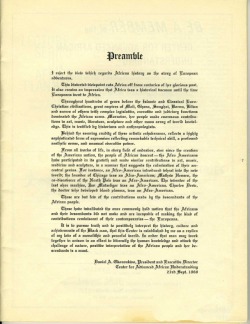In 1968, African students at the University of Minnesota came together to form a non-profit educational organization, the Center for Advanced African Understanding (CAAU). Their mission was to educate the American public on African politics, culture, and history. Africa was still considered by many to be the “dark continent,” a land of cannibalism and tribal warfare. But the students from Africa knew a different homeland, and they wanted to share that knowledge with the citizens of Minnesota and the world.
CAAU was the creation of a political science student, Daniel Ajah Okoronkwo, from Nigeria. Under his leadership, CAAU was established at 1149 Aldrich Avenue in Minneapolis. From that location, African students volunteered their time to provide demonstrations in areas such as African modes of dress and cooking. Minnesotans could stop by CAAU to obtain guidance on travel and cultural matters in Africa. CAAU produced the “African Image” magazine, a monthly publication devoted to scholarly and critical analysis of African issues.
The concept was revolutionary for its time. In 1968, most American colleges, including the University of Minnesota, had few courses devoted to African studies. To compensate, CAAU would provide African Studies lectures on topics such as Pan-Africanism, African Religions, and History.
CAAU and the African Image magazine may have encouraged minority students to petition for greater inclusion in Academic affairs. In January 1969, Black American students forcibly took over the University of Minnesota’s records office, demanding that the University improve its attitudes towards minorities. Their requests included the demand for an Afro-American Studies Department (AASD). When this Department was created, it incorporated many areas of study promoted by the CAAU. With the establishment of the AASD, the goals of CAAU had partially been accomplished. While AASD was assured permanent funding, CAAU’s support was limited. Thus, CAAU soon ceased to exist.
Although CAAU was short-lived, its staff continued to contribute to the African cause. Amos Odenyo, the senior editor of the African Image magazine, taught Kiswahili in the AASD from 1969 until 1971. Odenyo's courses were to be the first regular courses offered by the AASD, according to the Minnesota Daily magazine (on August 21, 1969). In 1971, Dr. Odenyo moved to New York, where he became Chairman of Social Sciences at York College, City University of New York. CAAU’s founder, Daniel Ajah Okoronkwo, moved to California after obtaining a B.A. degree in Political Science from the University of Minnesota, and completing three years of studies towards a law degree at Hamline University School of Law. Okoronkwo continues to be an author, and is involved in entrepreneurial activities. He founded U.S.A. Guinea Foundation, Inc., a California Public Benefit Corporation chartered in 1990.
On a personal note, both Daniel Okoronkwo and Amos Odenyo had similar origins. They were born in the mid-1930s in colonial Africa. They both became police officers (in Nigeria and Kenya) in the late 1950s. They immigrated to the United States in the early 1960s, in pursuit of higher education. Both Okoronkwo and Odenyo became citizens of the United States, but remained dedicated to their original dreams of education and development within their native African homeland. This webpage is dedicated to their dream of a positive African Image.
CAAU was the creation of a political science student, Daniel Ajah Okoronkwo, from Nigeria. Under his leadership, CAAU was established at 1149 Aldrich Avenue in Minneapolis. From that location, African students volunteered their time to provide demonstrations in areas such as African modes of dress and cooking. Minnesotans could stop by CAAU to obtain guidance on travel and cultural matters in Africa. CAAU produced the “African Image” magazine, a monthly publication devoted to scholarly and critical analysis of African issues.
The concept was revolutionary for its time. In 1968, most American colleges, including the University of Minnesota, had few courses devoted to African studies. To compensate, CAAU would provide African Studies lectures on topics such as Pan-Africanism, African Religions, and History.
CAAU and the African Image magazine may have encouraged minority students to petition for greater inclusion in Academic affairs. In January 1969, Black American students forcibly took over the University of Minnesota’s records office, demanding that the University improve its attitudes towards minorities. Their requests included the demand for an Afro-American Studies Department (AASD). When this Department was created, it incorporated many areas of study promoted by the CAAU. With the establishment of the AASD, the goals of CAAU had partially been accomplished. While AASD was assured permanent funding, CAAU’s support was limited. Thus, CAAU soon ceased to exist.
Although CAAU was short-lived, its staff continued to contribute to the African cause. Amos Odenyo, the senior editor of the African Image magazine, taught Kiswahili in the AASD from 1969 until 1971. Odenyo's courses were to be the first regular courses offered by the AASD, according to the Minnesota Daily magazine (on August 21, 1969). In 1971, Dr. Odenyo moved to New York, where he became Chairman of Social Sciences at York College, City University of New York. CAAU’s founder, Daniel Ajah Okoronkwo, moved to California after obtaining a B.A. degree in Political Science from the University of Minnesota, and completing three years of studies towards a law degree at Hamline University School of Law. Okoronkwo continues to be an author, and is involved in entrepreneurial activities. He founded U.S.A. Guinea Foundation, Inc., a California Public Benefit Corporation chartered in 1990.
On a personal note, both Daniel Okoronkwo and Amos Odenyo had similar origins. They were born in the mid-1930s in colonial Africa. They both became police officers (in Nigeria and Kenya) in the late 1950s. They immigrated to the United States in the early 1960s, in pursuit of higher education. Both Okoronkwo and Odenyo became citizens of the United States, but remained dedicated to their original dreams of education and development within their native African homeland. This webpage is dedicated to their dream of a positive African Image.


















